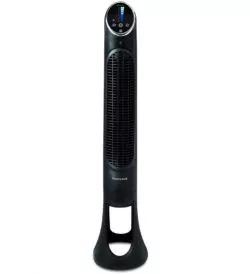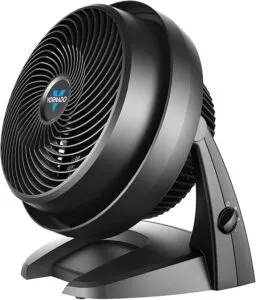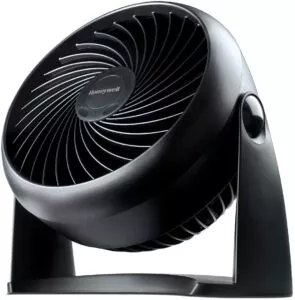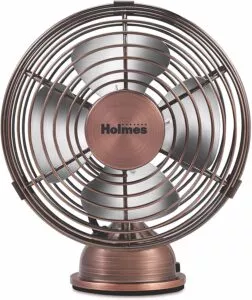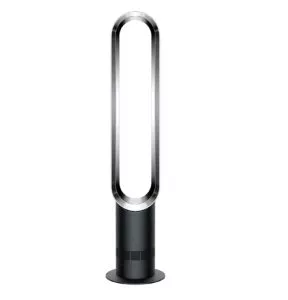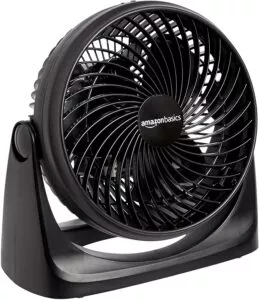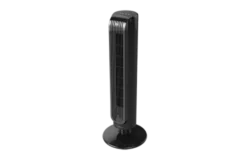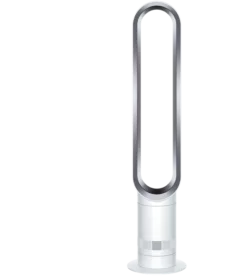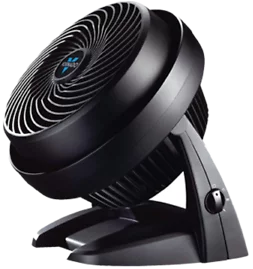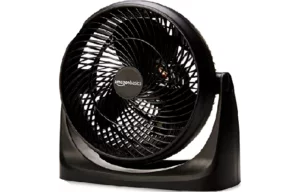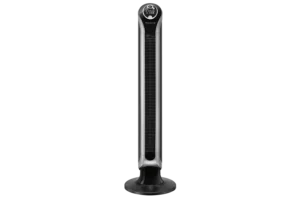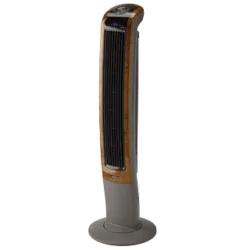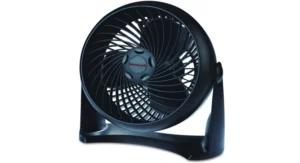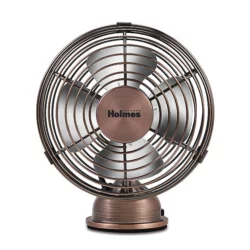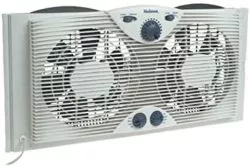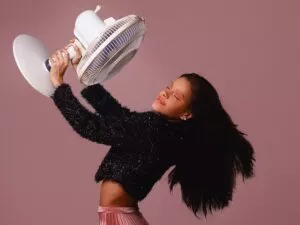
The Best Fans in Canada
Summers are heating up a little more each year. You don’t want to have to stalk the empty shelves of all your local Canadian Tires searching for a fan amid a heatwave. Instead, plan ahead and make sure you purchase the best fan before you need it. Trust us, you’re going to need it. And if you’re worried that it will be a waste for the six months of winter, then you should know that with the right purchase, you can also put it to use to enhance your existing HVAC system. Use it to exhaust hot air from inside, spread hot air from your furnace or redistribute air from your air conditioner. You can even use it along with a wet towel to boost its cooling effects! Find the best fans for summer right here.
Our top picks
How to choose a fan
You don’t want to invest in a fan only to find out that it’s too heavy for your desk or too loud for your bedroom. That’s why we’ve organized the criteria so you can see if that fan you just spotted would work for you. Canada’s summers can be brutal too. So, don’t wait until the next heatwave hits before you run to the store.
First, you’ll want to jump to our FAQ section and find out if an air circulator or a traditional fan is the right one for you. Besides that, you should consider:
- Volume: Generally, the faster your blades spin, the louder the motor will be. If you’re purchasing a fan for your home gym, the trade-off on volume for power might be worth it. And while there are some steps you can take to quiet a rattling fan, finding a fan or circulator that’s made to be whisper quiet for your bedroom will be a wiser investment. For a general guideline, roughly 60 dB is the volume of normal conversation.
- Ventilation: This is how cool it’s able to get your room. This factor hinges on the size of the fan, the area of the room, and how fast it spins/pushes air through.
- Size: This mainly determines how appropriate the fan is for a particular setting. You wouldn’t want a tower fan standing on your desk, blowing away your paperwork in a torrent! And you’ll be disappointed by a small fan in the corner of your room with the cool breeze on your ankles. So, pick a model of a fan that suits the size of the area you intend to cool down.
- Settings: This is how many different speeds you have to choose from. Some only have a high/low speed, which is appropriate for a small area. Others have many more.
How we picked the best fan
Chances are, you ended up here because you were searching around online for the best fan. We did the hard part for you and spent at least 20 hours researching and writing on the best fans available in Canada. We searched high and low across the net to find what everyone reviewers and past purchasers alike, had to say about these products to find those that consistently got the best reviews.
Best tower fans
Honeywell Quietset Whole Room
You can hardly go wrong with a Honeywell tower fan, but what sets this one apart is the fact that you’ll quickly forget that this fan is even in your home. With its slim, non-imposing profile, it practically disappears into the corner of your room. It comes with 8 different speed settings to customize the airflow with a range of roughly 10 – 15ft., so you’ll be able to cool down every corner of your room. What makes this the best fan for your bedroom is the fact that on its loudest setting it only hums at 63 decibels and features an LED display that’s dimmable. That makes it perfect for sleeping.
Pros
- Dimmable LED display.
- Quiet.
- Affordable.
Cons
- Not super powerful.
Lasko 32″ tower fan
If you live in a small unit, then this fan may be the one for you. Standing just under 3ft. with a narrow profile, and small angle of oscillation, this fan won’t take up much space in your room. That’s why we think this would be the best fan for cooling an apartment or office space; somewhere where there isn’t much real estate to spare. It’s also quiet enough that it won’t disrupt your work or sleep.
Pros
- Quiet.
Cons
- Narrow angle of oscillation.
Dyson Air Multiplier 07
If you’re looking to splurge on any piece of house-tech, Dyson has got you covered. Their engineering is always innovative, and the design is always sleek and futuristic. However, the most affordable model of a Dyson fan is easily 5x more expensive than other brands. It uses the physics of turbulence to push a concentrated breeze without blades, meaning its safe for those with babies or pets around. This design also makes it easy to clean by just wiping it down. So, while it cools like an air conditioner, it’s up to you to decide if it’s worth spending on.
Pros
- Bladeless.
- Powerful.
- Quiet.
- Easy to clean.
- Safe.
Cons
- Extremely expensive.
Best air circulators
Vornado 630 medium air circulator
If you’re struggling to keep your room temperature even, you’re likely to have heard of a Vornado fan. The innovative design pushes around a lot of air without knocking it off balance. This means that it can keep your room feeling cool, even if it’s on the larger side. If you can get your hands on its quieter successor, the Vornado 660, then go for it. But for most Canadians, this one does have some white noise, which may or may not be a deal-breaker for you.
Pros
- Sturdy base.
- No rattling.
- Moves a lot of air.
Cons
- White noise.
AmazonBasics air circulator
The value you get for this circulator vastly outweighs the price. It’s not even $20 and offers you 3 speeds. It’s surprisingly quiet and energy efficient, given its low cost. It’s quite small (sort of, at 7-inches), making it perfect for your desk or bedside.
Pros
- Cheap.
- Quiet.
Cons
- Only covers small areas.
Best oscillating fan
Rowenta Fresh 180 tower fan
We named this the best oscillating fan because it stands at nearly just over 3ft. with 180° oscillation, this fan provides a wide enough coverage for a large room. It’s also an energy-efficient fan, only drawing 40-70w with an eco-friendly automatic shut-off, so you’ll never worry about it running while you’re away from home. It’s surprisingly quiet, working at just 45-60 decibels. And— perhaps, the best feature of all— it automatically adjusts the speed based on the temperature of the room. So, no more fiddling between two speeds to get that perfect breeze.
Pros
- Eco shut-off.
- Wide coverage.
- Temperature auto-adjust.
- Easy cord storage.
- Quiet.
Cons
- Watch battery needed.
- Battery not included.
Best fan for your workout room
Lasko Wind Curve
The reason we said this one is the best for your indoor cycling session is its compact size and footprint. You can just tuck it in the corner between all your exercise equipment and have it sweep the entire room. At nighttime, you can also easily transport it your bedside as it’s also a relatively quiet bedroom fan. It has a night-shift mode that gradually decreases the air flow in case you’re the type to wake up congested by the fan.
Pros
- Compact.
- Nighttime setting.
Cons
- None.
Best fan under $100
Honeywell HTC 900C Turboforce
This is an affordable option for anyone on a budget, clocking in at under $50. It has a compact size making it good as a floor fan but can be easily mounted on the wall if that’s your preference. Use it all year-round to boost your HVAC and save on your energy bills.
Pros
- Extremely affordable.
Cons
- None.
Best desk fan
Holmes Heritage desk fan
Let’s be honest. A big plus with this fan is it looks cool. It’s a brushed-copper fan for a rustic look and feel. It’s tiny enough to be discrete and cute, but still carries enough weight that it doesn’t feel flimsy. It’s USB powered, so it can be plugged in right into your computer and won’t push around so much air that it sends all your paperwork flying.
Pros
- USB Powered.
- Tiny.
- Aesthetic.
Cons
- On/off only.
Best window fan
Holmes Dual 8″ blade twin window fan
For those of us just looking to push out the summer heat this fan is for you. You have control over each individual fan’s speed and direction, so you have full control over the air exchange and flow. It’s designed to fit in most slider and hung windows and can be extended to fit. The knob in the centre controls a thermostat that automatically turns the fan on or off depending on what you choose. While you shouldn’t let water run into the fan, it is safe to use on rainy days, making it the perfect fan for all summer weather.
Pros
- Fans work independently of one another.
- Can blow in either direction.
- Safe for rainy-day use.
- Comfort control thermostat.
Cons
- Ugly.
Frequent questiions about fans
How can I make my fan quieter?
It can be a pain to decide between a noisy fan and sleeping through a heatwave. But there are some steps you can take to lessen the rattling caused by your fan. If you want to reduce fan noise, try the following:
- Make sure the fan is level.
- Place it on a soft surface.
- Clean the components.
- Lubricate the motor.
- Tighten any loose bolts.
Which way does a fan turn in summer?
Counter-clockwise.
Tip to remember: CW for clockwise and Christmas-Winter.
How does a bladeless fan work?
You’re not the only one that’s been wondering how the Dyson fan works. It’s just a simple matter of physics. For one, bladeless fans aren’t technically bladeless, as there are some on the turbine inside of the fan. The long and short of how it works is the turbine sucks in air and forces it up and out through a narrow opening making a quieter stream of cool air.
They have a video of a more detailed explanation here.
Are Dyson fans worth it?
While they do have a luxury price tag, no one disputes that Dyson offers a range of innovative, beautifully designed products. If you want to splash some spare change on a luxury item, then don’t worry, you didn’t waste your money. On the other hand, if you’re just looking for a fan, there are ones that work just as well for a fraction of the price.
How much does it cost to run a fan all night?
This is dependent on many different factors, such as how powerful the fan is, the electricity rates in your area at the time you use it, and how long you leave it on all night. However, once you know your parameters, it’s fairly easy to calculate the cost of running your fan.
[Consumption (kW)] x [Hours in use] x [Electricity rate (¢/kWh)]
If you don’t know how much electricity a fan uses, most residential fans on the market use between 30 and 100W depending on the size and setting. So, let’s say you use the highest setting, for eight hours a night, and your electricity rate’s is 10¢/kWh. That’s [100 W ÷ 1000] x [8 hrs.] x [10¢], which comes to 8¢ every night you leave your fan on. Compared to the standard air conditioner that uses 3500W, that’s $2.80. Meaning investing in a fan could save you a significant amount of money in the long run.
Air Circulator vs. Fans
Air circulators keep the air in a room in motion whereas a fan directs a stream of high-speed air outwards. Circulators help even out the temperature of rooms, so if you find that there’s one room in the house that’s constantly stuffy despite blasting the HVAC, then a circulator can help you even out that room, no matter the season, and help you lower your energy bill.
If your needs don’t seem like they’ll be met with a circulator—perhaps, the room doesn’t have circulating issues but you’d just like a cool breeze to pass over you while you sit on the couch—then a fan would be suitable for you. After all, you don’t want to spend a heatwave with a circulator that has nothing but hot air to push around.
What’s the best position for your circulator/fan?
If you have got an air conditioner, that’s no reason to pack up your circulator just yet. You can use your circulator to boost the cooling sensation of your AC to save on your utilities.
Summer:
–In hot weather, when the AC is on, place the circulator at a roughly 90° angle from the unit, facing the rest of the room, to push the cool air. This helps you feel cooler, faster.
–Direct your circulator at the top of the stairs, to force cool air upstairs. If you have an open window nearby, have the back of the unit slightly towards the window to pull in cool air from outside.
-If outside is cooler than inside, point your fan facing outside to push out the hot air out. Otherwise, you’ll want the stream directed towards you.
Spring/Fall:
–Take advantage of the fresher seasons, or those early morning hours by facing your fan towards the room at a 45° angle. If you have a window open, face your unit slightly away from the window and towards the room.
Winter:
–Point your unit towards the ceiling. Place it beside any other heating systems, if you have them on, such as a furnace, to maximize efficiency.
Read more
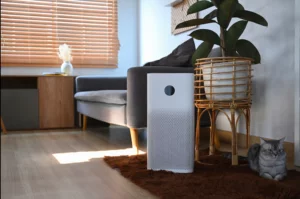
How Do Air Purifiers Work?
Polluted air can be life-threatening, but can an air purifier help with that? Find out here.
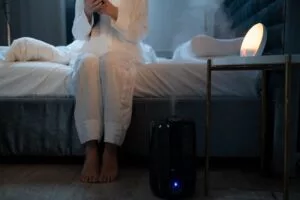
The Best Humidifiers in Canada
Keep your home air comfortable all year with the help of a humidifier!

The Best Rice Cookers in Canada
A worldwide staple, rice is the perfect side to any dish. Cook it perfectly everytime with this selection of rice cookers.
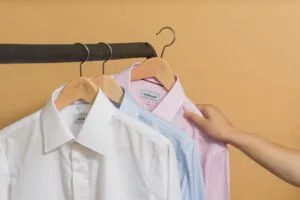
The Best Steamer for Clothes in Canada
Gently remove wrinkles without ruining your clothes with a variety of fabric steamers.
